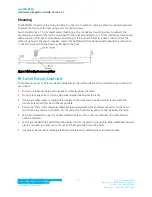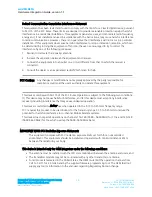
Laird MSD45N
Hardware Integration Guide, version 1.1
Embedded Wireless Solutions Support Center:
http://ews-support.lairdtech.com
www.lairdtech.com/wireless
4
Laird Technologies
Americas: +1-800-492-2320 Option 2
Europe: +44-1628-858-940
Hong Kong: +852-2268-6567 x026
S
COPE
This document describes key hardware aspects of the Laird MSD45N radio module. This document is
intended to assist device manufacturers and related parties with the integration of this radio into their host
devices. Data in this document is drawn from a number of sources and includes information found in the
Qualcomm Atheros (QCA) AR6003 data sheet issued in January 2010, along with other documents provided
from Qualcomm Atheros.
The information in this document is subject to change. Please contact Laird Technologies or visit
http://www.lairdtech.com/wireless
to obtain the most recent version of this document.
O
PERATIONAL
D
ESCRIPTION
This device is a Laird MSD45N radio module which supports IEEE 802.11a/b/g/n
standards via an SDIO (Secure Digital Input/Output) interface. The radio operates
in unlicensed portions of the 2.4 GHz and 5 GHz radio frequency spectrum. The
device is compliant with IEEE 802.11a, 802.11b, 802.11g, and 802.11n standards
using Direct Sequence Spread Spectrum (DSSS) and Orthogonal Frequency
Division Multiplexing (OFDM). The device supports all 802.11a, 802.11b,
802.11g, and 802.11n data rates and automatically adjusts data rates and
operational modes based on various environmental factors.
When operating on channels in the UNII-2 and UNII-2 Extended bands that are in
the 5GHz portion of the frequency spectrum and are subject to Dynamic Frequency Selection requirements,
the MSD45N fully conforms to applicable regulatory requirements. In the event that specified types of radar
are detected by the network infrastructure, the MSD45N fully conforms to commands from the infrastructure
for radar avoidance.
The MSD45N interfaces to host devices via a 60-pin connector. The device is based on the Qualcomm
Atheros AR6003 chip which is an integrated device providing a Media Access Controller (MAC), a Physical
Layer Controller (baseband or BB processor), and fully integrated dual-band radio transceiver. To maximize
operational range, the MSD45N incorporates external 2.4 and 5 GHz power amplifiers (PA) to increase
transmit power. The frequency stability for both 2.4 GHz (802.11b and 802.11g) and 5 GHz (802.11a)
operation is +/- 20 ppm.
On the interface connector (Molex 60-pin connector; pin 21), an I/O voltage level configuration (either 3.3 V
or 1.8 V) is required from the host platform to configure the SDIO bus signal to run at a 3.3 V or 1.8 V signal
level. The MSD45N also provides the 3-wire Wi-Fi/BT coexistence signals to ensure the performance of Wi-Fi
and BT system when they reside in the same platform. A cellular coexistence filter is implemented on the
MSD45N to provide robust performance when implemented with a cellular system.
The MSD45N has its own RF shielding and does not require shielding provided by the host device into which
it is installed in order to maintain compliance with applicable regulatory standards. As such, the device may
be tested in a standalone configuration via an extender card.
The device buffers all data inputs so that it will comply with all applicable regulations even in the presence of
over-modulated input from the host device. Similarly, the MSD45N incorporates power regulation to comply
with all applicable regulations even when receiving excess power from the host device.
The MSD45N combines the 2.4 and 5 GHz signal path to signal U.FL type antenna connectors to support dual
band transmission and receive. An antenna diversity function is
NOT
supported in this product. Supported
host device antenna types include dipole and monopole antennas.
Regulatory operational requirements are included with this document and may be incorporated into the
operating manual of any device into which the MSD45N is installed. The MSD45N is designed for installation
into mobile devices such as vehicle mount data terminals (which typically operate at distances greater than 20
cm from the human body) and portable devices such as handheld data terminals (which typically operate at
distances less than 20 cm from the human body). See “
Documentation Requirements
” for more information.





































